William Herschel discovered infrared light in 1800 (Herschel 1800). R. W. Wood made the first outdoor infrared photograph in 1910 (Wood 1910). Robert Greenler was the first to publish an infrared photograph of a rainbow in 1971 (Greenler 1971). Vollmer and Shaw were the first to publish a pure infrared photograph of a 22° ice crystal halo (Figure 1, Volmer and Shaw 2017). All of these published findings involve near infrared (NIR) light, with wavelengths slightly longer than red light (i.e., not thermal infrared radiation).
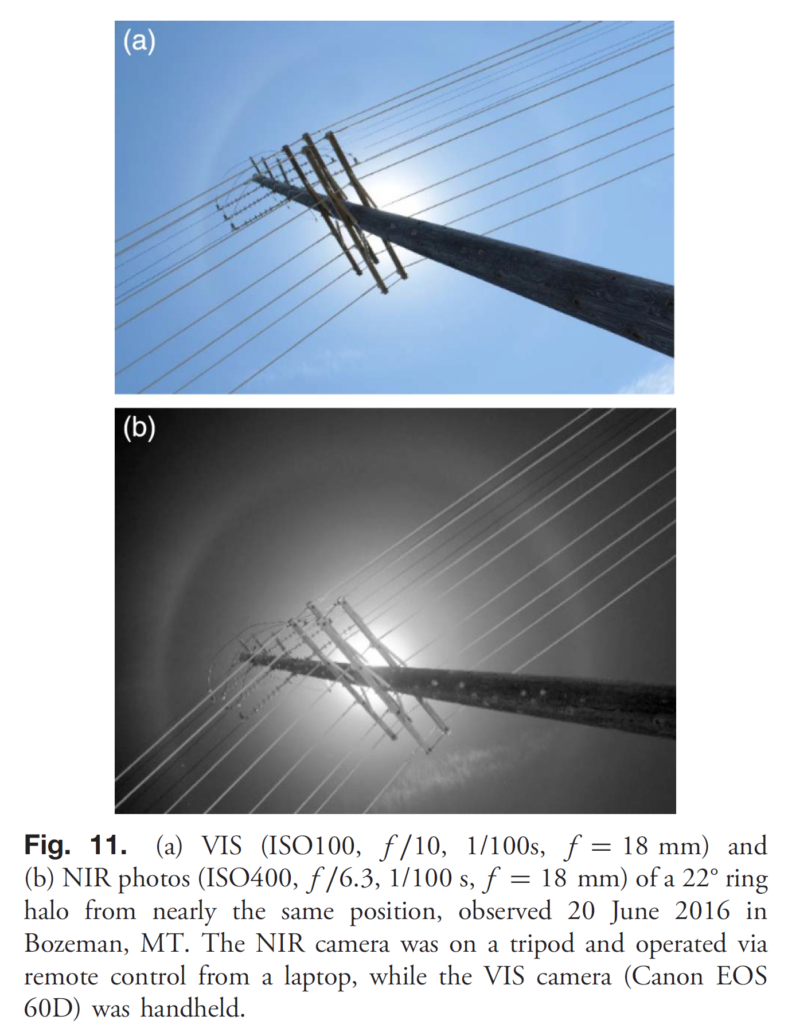
The existence of an invisible near-infrared band in ice crystal halos had been accepted long before Vollmer and Shaw published their photo of one in 2017. You don’t have to be a physicist to convince yourself that rainbows and halos have invisible NIR bands.
Below is a digital photo I took of a 22° ice crystal halo in June, 2014 (Figure 2). It was a warm day, and the ice crystals causing the refraction were in cirrus clouds many tens of thousands of feet above ground.
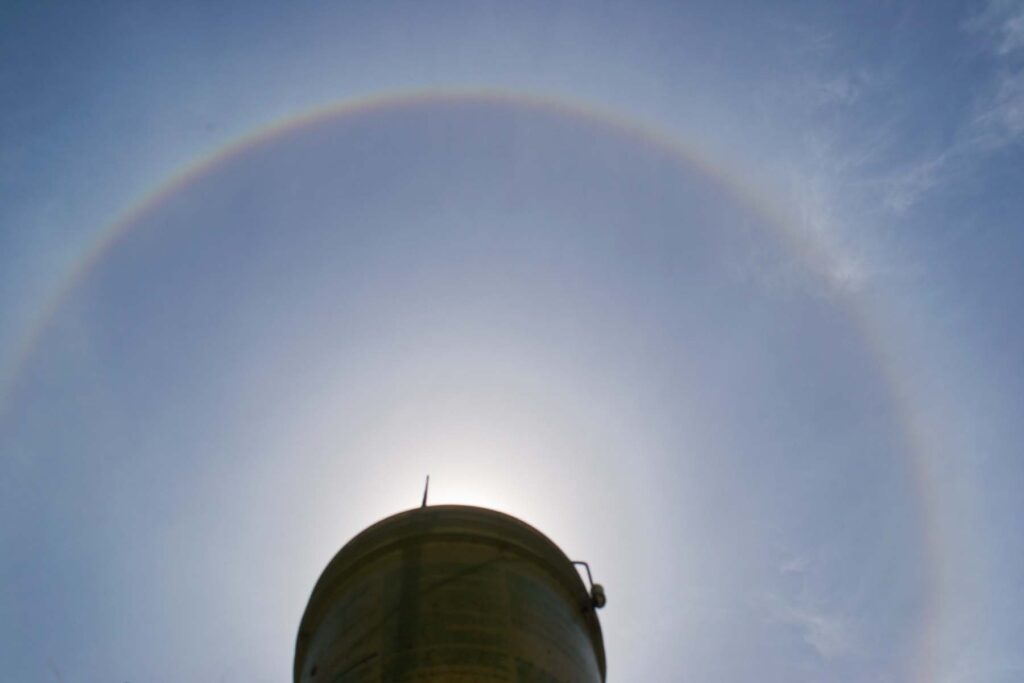
The ice crystals that produce 22° halos are short columns of hexagonal ice, like sawed-off pieces of pencil. They act as prisms to separate sunlight into the colors of the spectrum (Figure 3).
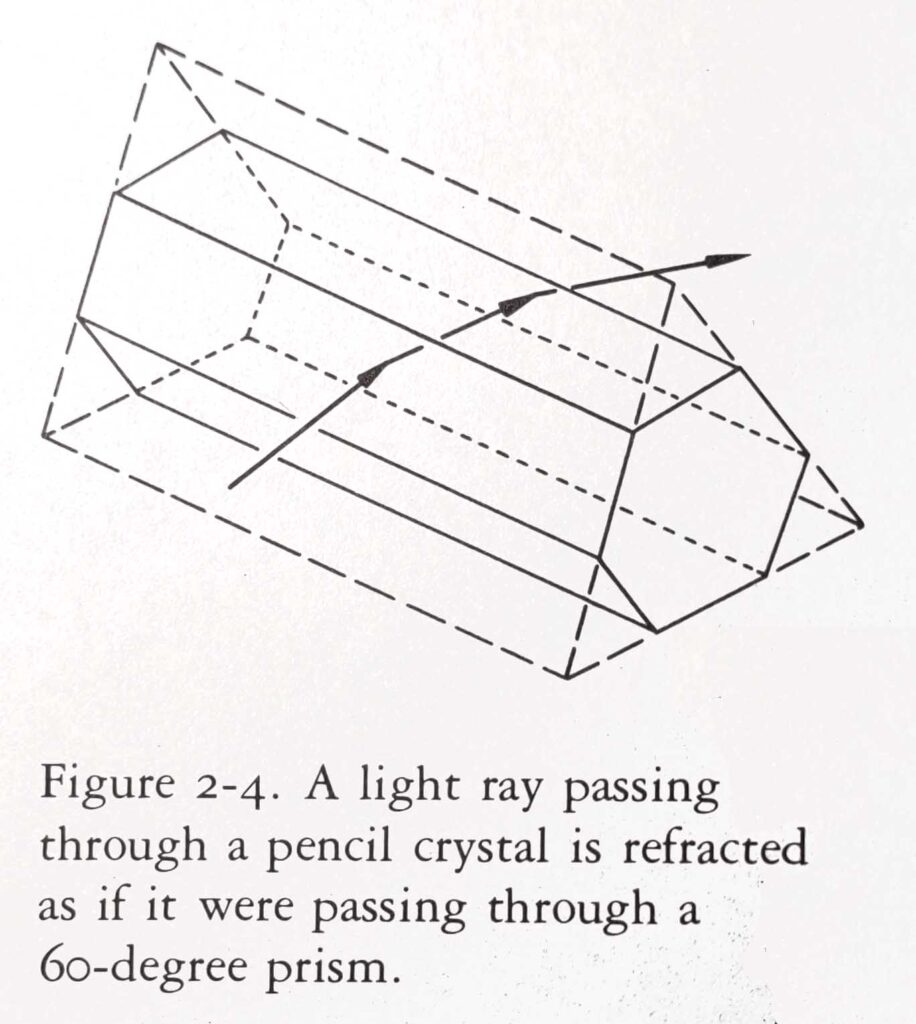
The separated colors exit a pencil crystal at an angle of about 22° relative to the entrance angle. The tumbling of the falling crystals ensures that anywhere in the sky that is 22° away from the sun there will be crystals oriented properly to bend the separated colors toward a viewer (or camera).
The colors in ice crystal halos are not as distinct as in rainbows, but there is typically a red band on the inside edge of a halo, then some shorter wavelength orange or yellow (see Figure 2). The shortest wavelength blues on the outer edge typically blend in with the blue sky or are scattered by the atmosphere. So we often see only ROY instead of the complete ROY G BIV spectrum.
When I saw the halo in Figure 2, I was experimenting with infrared cameras and wondered if the near infrared light in sunlight was also a part of the halo but invisible to the eye. In spectral order, near infrared light is next to red; it has longer wavelengths than red and would form a band of the halo inside red, so it would be just on the inside the visible halo. I had a digital camera that was modified to record near infrared light in one of the three color channels. I took a second photo of the halo with this modified camera.
I used an image analysis program called FIJI (an acronym for “FIJI Is Just Image-J”) to separate the normal color photo into its three color channels (Figure 4). The three “channels” are just three black-and-white images captured simultaneously by the camera’s sensor. Each channel is made by an array of pixels covered with appropriately colored filters. Combining the channels produces a color photo.
An emergent feature of digital cameras is that the three images made for each photo are perfectly aligned with one another. This allows precise analysis of where in each image different colors are present. In the case of my infrared modified camera, two of those images record mostly visible light, and the third is an almost pure near-infrared image.
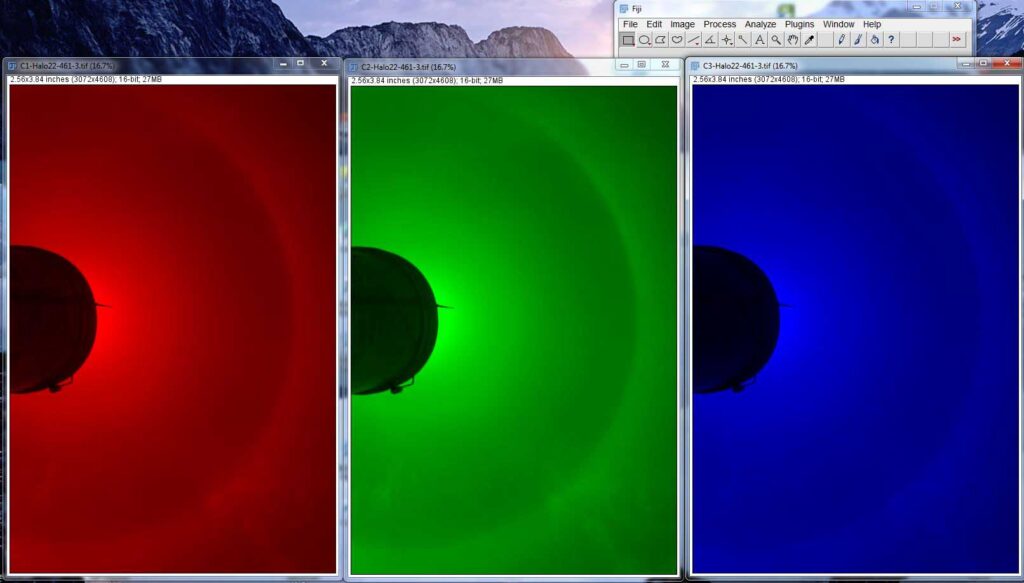
For each of the three channels in the normal photo of the halo, I used FIJI to report the brightness of the pixels along a transect from near the sun out to and across the halo (Figure 5). I expected the bright halos in the three channels to be offset; the red halo should be inside the green which is inside the blue.
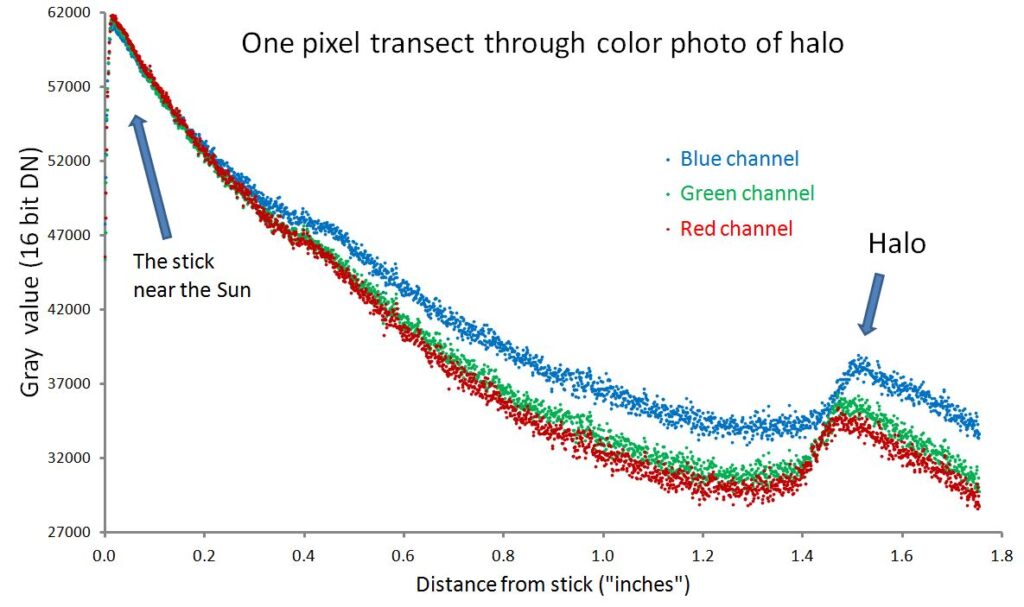
The transects across the three color channels document the halo as expected. The pixels are brightest (higher gray value) near the stick (close to the sun) and become dimmer toward the right until the area of the halo. The humps at the right of the graph are the brighter pixels in all three color channels where the transects cross the halo. Even the blue channel is brighter there, despite the fact that we don’t see an obvious blue band in the original color photo. As expected, the humps are in the spectral order R-G-B from left to right; red is the innermost band in the halo.
The same procedure was used on the infrared photo. The halo is clearly visible in all three color channels (Figure 6). The red and green channels of this modified camera capture a mix of visible and near-infrared light. The blue channel (at right in Figure 6) captures mostly near-infrared light. The question is: Is the halo in the blue channel (near-infrared light) smaller (on the inside of) the halos recorded by the other two channels?
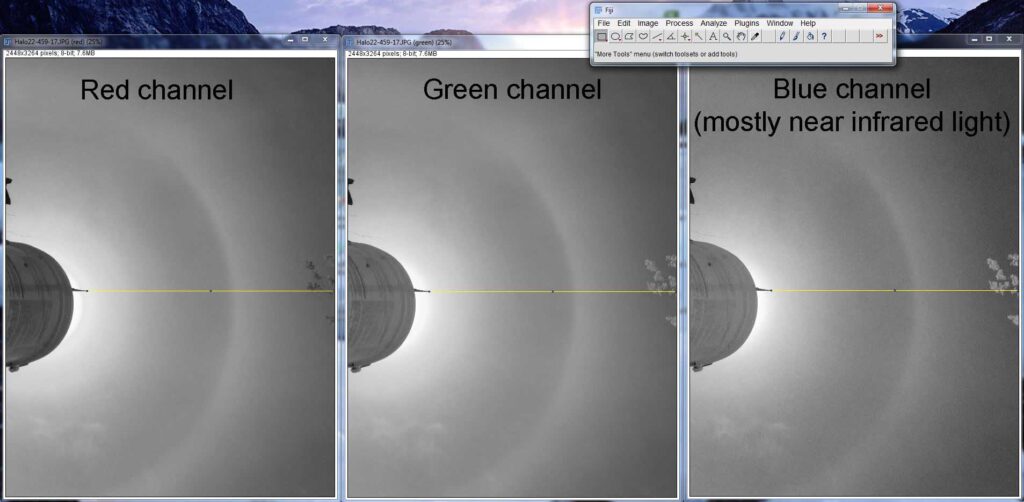
The pixels in the blue channel, which record mostly near-infrared light, are not as bright as the pixels in the other two channels (Figure 7, gray value is lower for the blue line). This is primarily because the camera’s sensor is not as sensitive to near infrared light. The important result is that the peak in the blue channel (arrow in Figure 7), indicating the position of the halo in that channel, is to the left of the peaks for the other channels. The infrared-sensitive channel recorded a bright band inside the bands recorded by the two visible light channels.
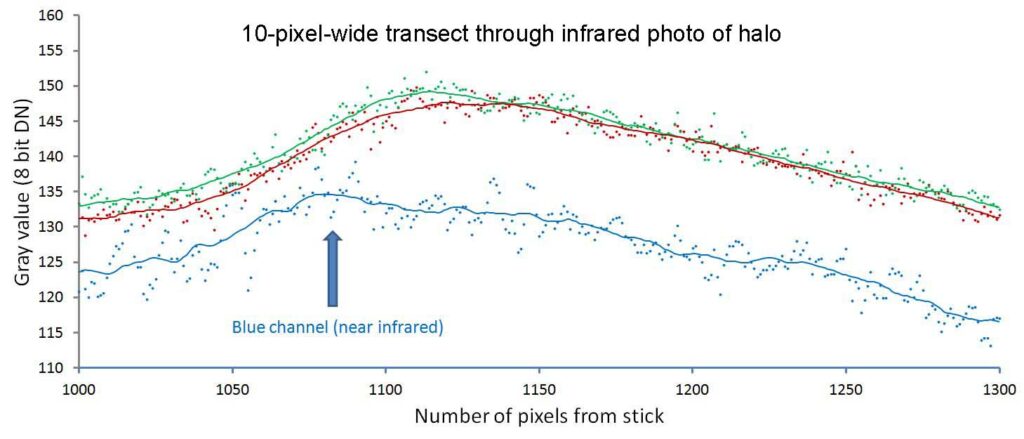
This is good evidence that a single photo from a home-modified 2008 point-and-shoot camera demonstrated the presence of an infrared ice-crystal halo. This halo is captured in the image of the blue channel from the infrared-modified camera (Figure 8). Vollmer and Shaw (2017) would dismiss that photo because it probably includes some visible light. However, the image analysis demonstrates that the peak intensity of the halo in that mostly infrared photo is inside the visible light halo; therefore that bright band must correspond with the near-infrared halo.
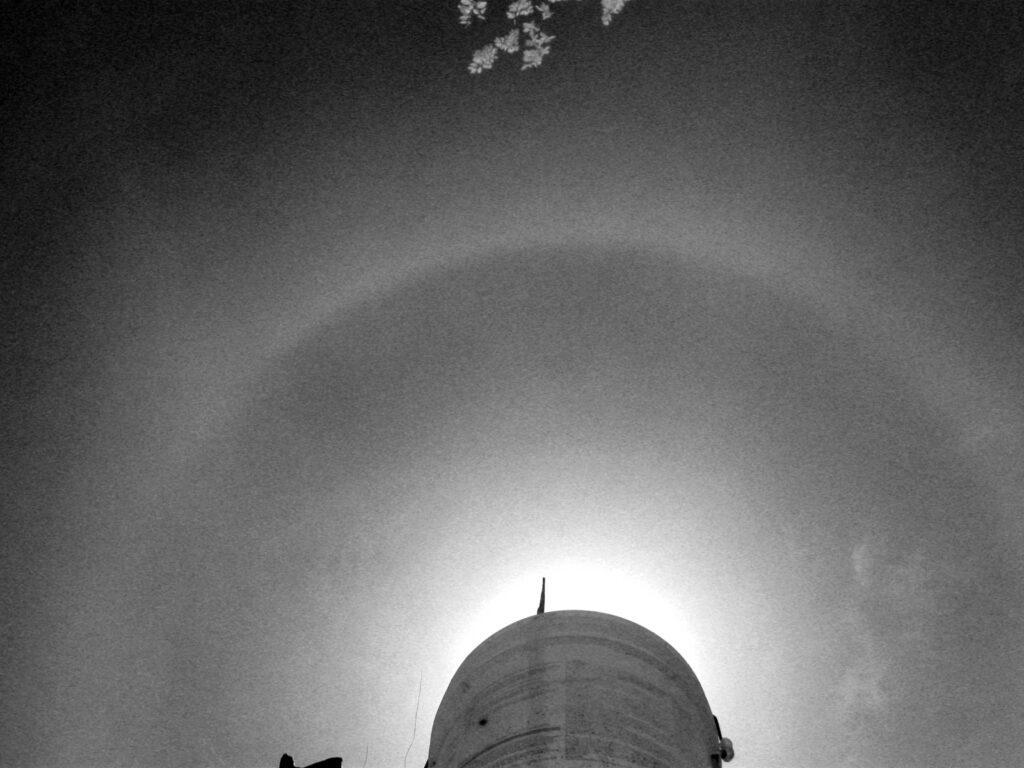
I guess I’m just going to let Vollmer and Shaw (2017) go on thinking they were first. I’m not going to dismiss their work just because their only contribution was to take a photo using a camera with a fancier filter than I had. I’m not going to discredit their 2017 statements (“We … report for the first time near-infrared photographs of 22° ring halos..”) just because nobody uses the term “ring halo.” I’m not going to dwell on their poor decision to use a ziggety telephone pole to block the sun in their “first” photo. My results (with the figures included here) were published in 2014 at publiclab.org for everyone to see.
Too bad the Public Lab website is now defunct. Rats.
References Cited
Greenler, R, 1971. “Infrared rainbow.” Science 173, 1231–1232. (abstract at JSTOR)
Herschel, W, 1800. “Experiments on the refrangibility of the invisible rays of the sun.” Philosophical Transactions of the Royal Society of London, 90, 284–292. (full text)
Vollmer, M and JA Shaw, 2017. “Atmospheric optics in the near infrared.” Applied Optics Vol. 56 No. 19. (full text)
Wood, RW, 1910. “Photography by Invisible Rays.” Photographic Journal, 1910, vol. 50, p. 329.
